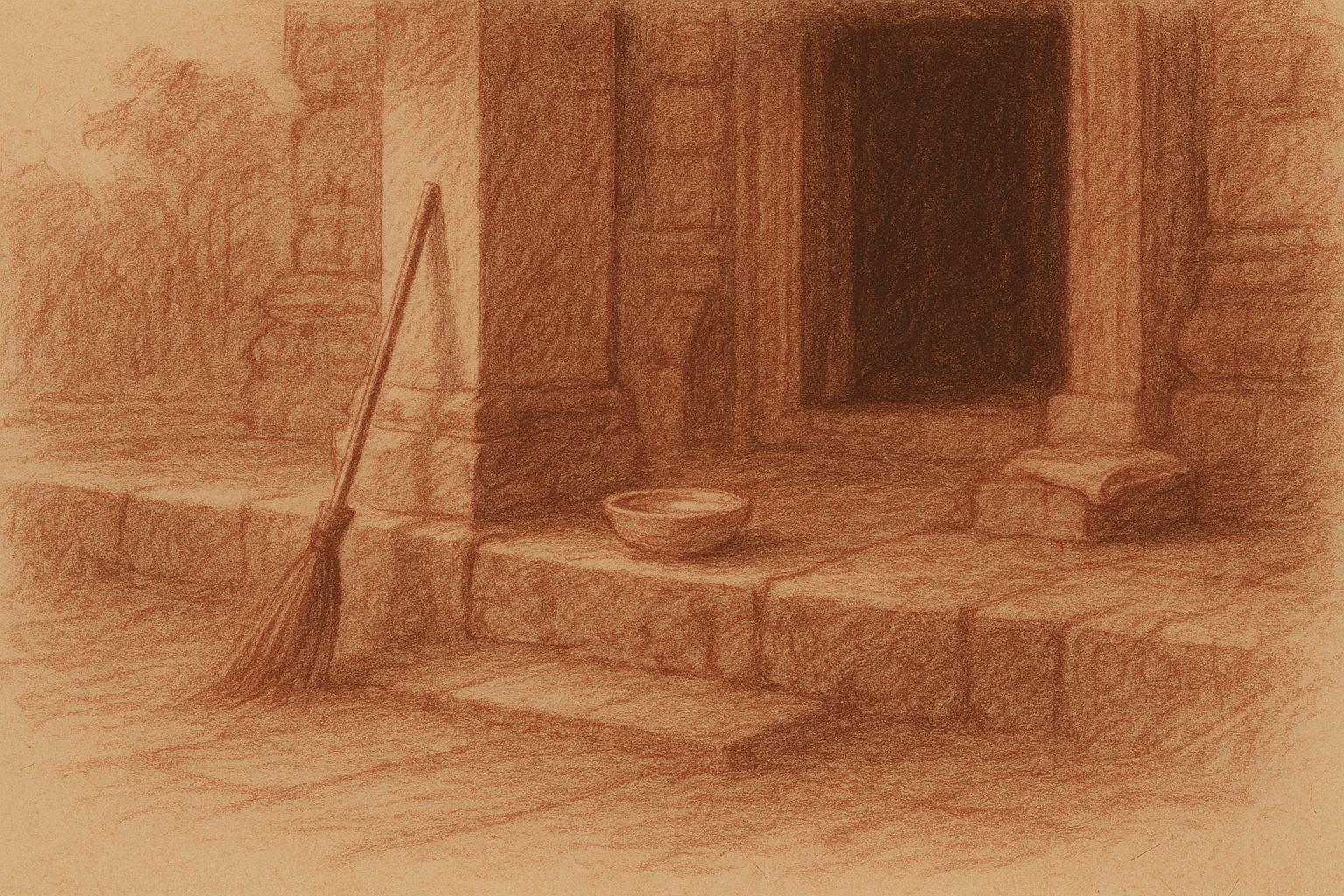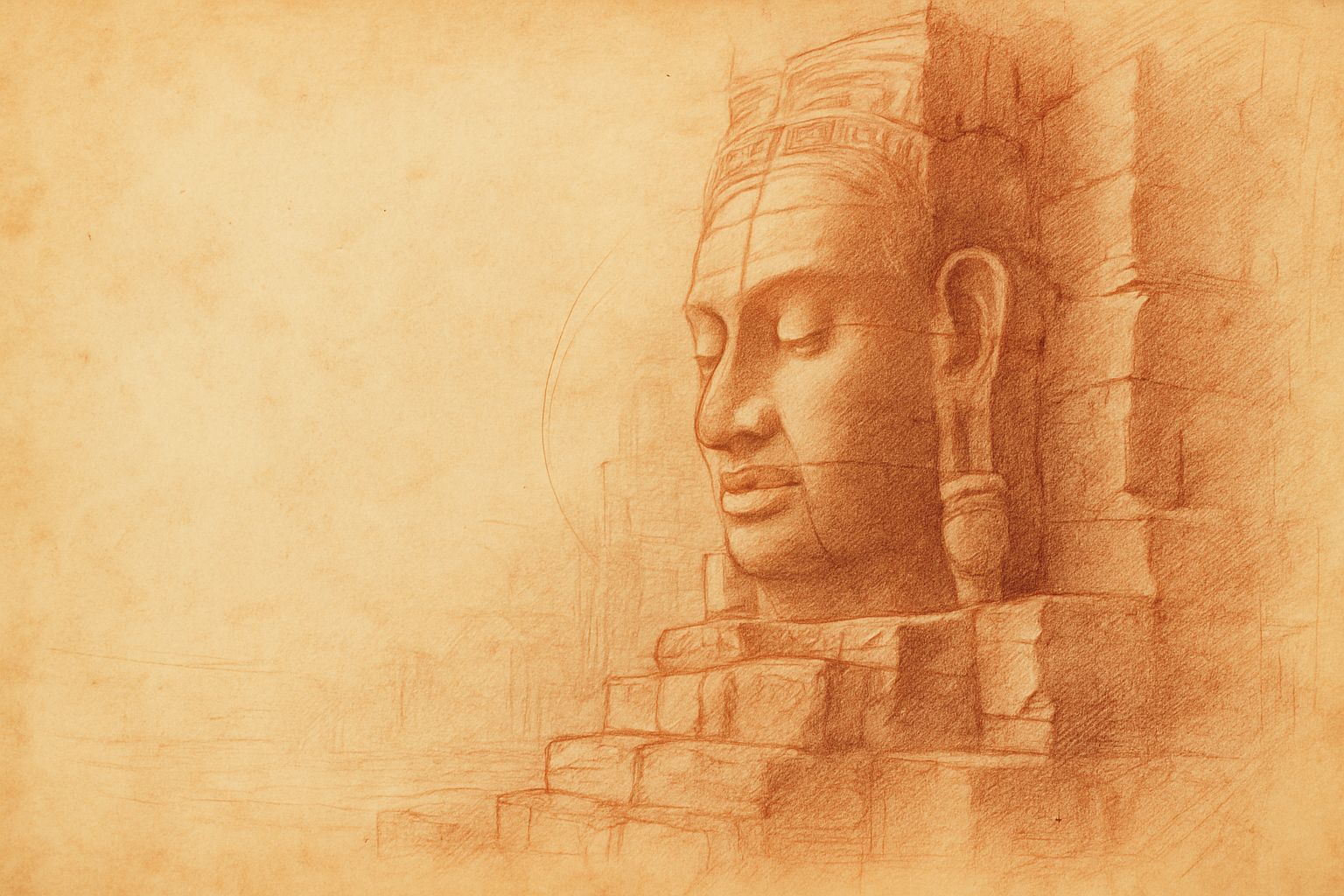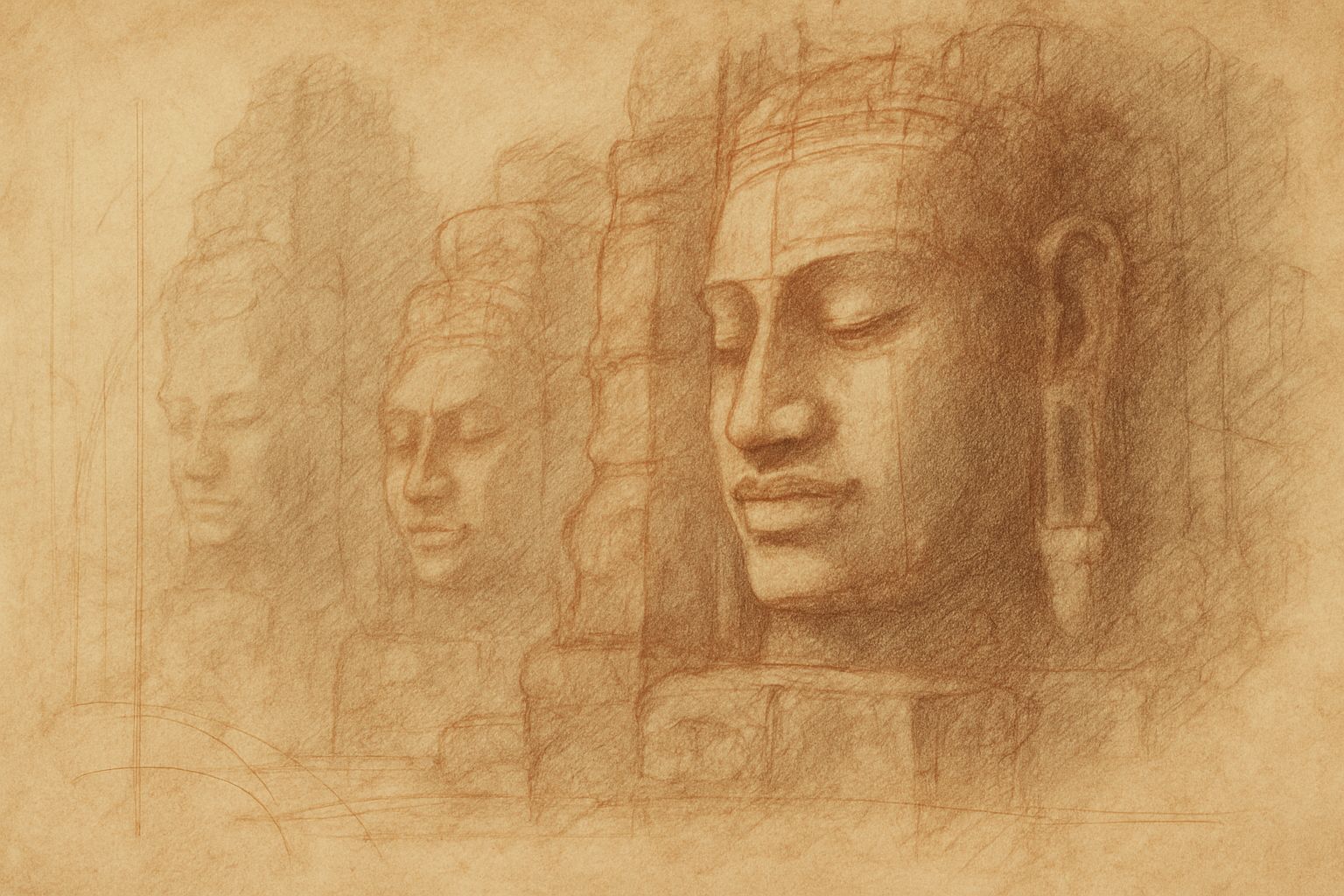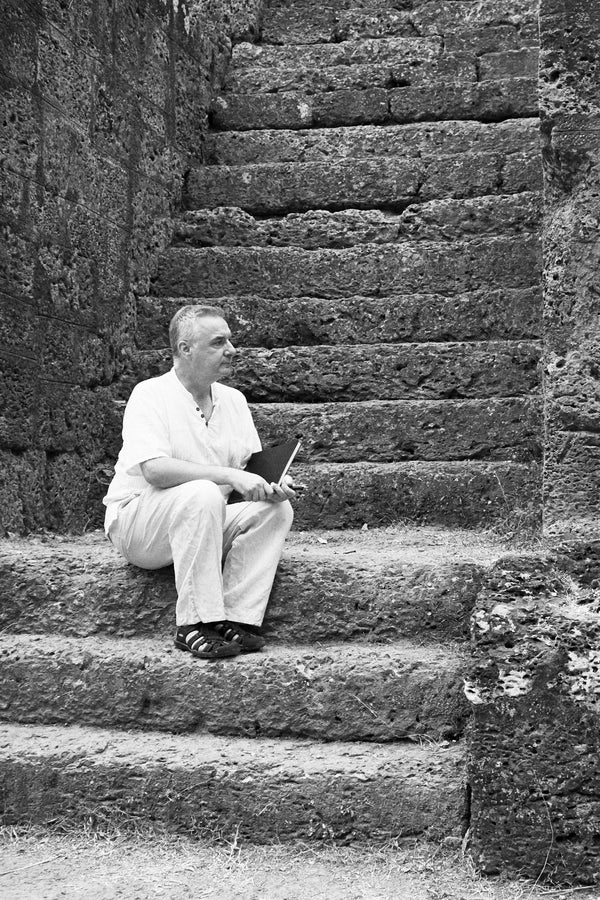Complimentary worldwide shipping on orders over $400 · No import tariffs for most countries
Complimentary worldwide shipping on orders over $400 · No import tariffs for most countries

The Elephant Who Bowed to Silence
On the Subjugation of Nalagiri at Preah Palilay
He who meets wrath with silence
breaks neither the world
nor the soul.
—
The rain had not yet come, but the forest felt already washed in stillness.
Annie and I moved slowly beneath the green hush of Preah Palilay, that hidden Theravāda jewel folded into the northern woods of Angkor Thom. Not far from the great avenues of the Bayon, yet worlds away in spirit, its gopura and sanctuary rise among tangled roots and quiet earth, sheltered by trees that seem to bend inward, as if listening. The parrots screeched, the cicadas shimmered, and high above us, monkeys whooped through the branches like wind over hollowed bells.
But here below, all was gentled.
On the northern pediment of the gopura, I found a vision rendered in stone—a quiet miracle softened by age and moss. It told the story of Nalagiri, the maddened war elephant who bowed before the Buddha. I had seen this tale in books and temples across Southeast Asia, but never so hushed, never so near.

The Subjugation of Nalagiri, Preah Palilay, Angkor, Cambodia.
Carved on the northern pediment of the gopura, the Buddha’s serene gesture stills the elephant’s fury into reverence.
Nalagiri appears twice in the carving. In the background, he charges—trunk lifted, tusks flared, rage carved in stone. And in the foreground, that same force is transformed: his great bulk kneels before the Buddha, tamed not by chains but by presence. The Enlightened One stands serene, his right hand resting upon the elephant’s bowed head—not in conquest, but in quiet grace.
There are no flames here. No spears or incantations. Only silence, and a turning.
The story, as it is told, begins in Rajagriha. Thirty-seven years after his awakening, the Buddha walked barefoot through the city on his alms round, cloaked not in protection but in presence. His cousin, Devadatta—consumed by envy—had tried to kill him before. Once with assassins, who fell instead into discipleship. Once with a boulder, which missed its mark. This time, he loosed an elephant drunk on rage.
Nalagiri rampaged through the town. He shattered carts, sent birds wheeling from rooftops, and trampled everything in his path. But as he neared the Buddha, something shifted. The air thickened. The noise thinned. The elephant slowed. And in the space between one breath and the next, his fury melted.
He bowed.
Trunk curled to dust,
the great beast remembered
what no weapon could teach.
From that moment, Nalagiri lived in peace.
Devadatta, however, continued on his path of division. He fractured the monastic community, fell into illness, and died unreconciled. In Khmer imagination—as carved into the judgment galleries of Angkor Wat—he descended into Avīci: the “hell without rest.” There, the damned are hung on thorned trees or skewered on spikes. There is no death in Avīci, only the endless repetition of self-inflicted suffering. It is the realm reserved for those who had everything, yet chose only grasping.
But Nalagiri was not damned. Nalagiri was transformed.
—
That we can still see this tale at Preah Palilay is a grace beyond its carving.
Although Buddhism entered Cambodia early, few narrative reliefs remain—especially of Theravāda origin. What the temples once held has often been erased. In the 13th century, after the death of Jayavarman VII, the wave of iconoclasm known as the Hindu Reaction swept through Angkor. Images of the Buddha and bodhisattvas—especially those of Mahāyāna tradition—were hammered into silence. At Ta Prohm, Banteay Kdei, even the Bayon, you can still see the scars: faces cleaved, eyes obliterated, serenity turned faceless.
Yet at Palilay, this gentle miracle endured.
Why?
Perhaps because the image is Theravāda, not Mahāyāna—modest, uncloaked in divine excess. Perhaps because Preah Palilay stood humbly, away from royal attention. Or perhaps, as with Nalagiri himself, something unseen stood between the carving and the hammer.
Theravāda practice had long been tolerated, even under Śaivite kings. In the late 9th century, Yashovarman I permitted the building of Tep Pranam, a Theravāda sanctuary not far from here. The monks may have lived quietly enough to escape notice. Or perhaps it was the forest who shielded them, gathering its leaves like hands over prayer.
Or perhaps it was silence itself.
A kneeling elephant
beneath a lifted palm—
even stone remembers.
—
Among the Eight Great Miracles of the Buddha, this one remains dearest to me. Not for its spectacle, but for its stillness. The others—levitation, self-duplication, the taming of fire—dazzle the eye. But this? This speaks to something subtler. The ending of violence not by resistance, but by presence. The transmutation of rage by stillness. The turning of destruction into devotion.
As I stood beneath the pediment, the monkeys above grew quiet. A single breeze moved between the trees, and the stone breathed.
It is a strange thing to feel reverence for a carved elephant—but that morning, I did. Not for his strength, nor for his surrender, but for the invisible moment he chose to bow.
—
There are stories the forest keeps
in the folds of the stone.
Also in Library

Those Who Keep the Way Open — On the Quiet Guardians of Angkor’s Thresholds
3 min read
Quiet gestures shape the way into Angkor — a swept stone, a refilled bowl, a hand steadying a guardian lion. This essay reflects on the unseen custodians whose daily care keeps the thresholds open, revealing how sacredness endures not through stone alone, but through those who tend its meaning.

Multiplicity and Mercy — The Face Towers of Jayavarman VII
5 min read
A new vision of kingship rises at the Bayon: serene faces turned to every horizon, shaping a world where authority is expressed as care. Moving through the terraces, one enters a field of steady, compassionate presence — a landscape where stone, light, and time teach through quiet attention.

Stone That Dreams
4 min read
Bayon wakes like a mind emerging from shadow. Its many faces shift with light and breath, teaching that perception—and the self—is never singular. In walking this forest of towers, the pilgrim discovers a quiet multiplicity within, held together by a calm that feels both ancient and newly understood.
Original artist's print on bamboo paper.
Image 8 x 8 inches, 20.3 x 20.3 cm
Hand-signed and numbered on border recto.
Edition 5/25
This is an exceptional, individually crafted, museum-quality archival print on fine art paper.
It is accompanied by a unique certificate of authenticity to certify and preserve the provenance of your artwork.
Other print sizes and fine art framing services are available on request.
Supreme art is a traditional statement of certain heroic and religious truths,
passed on from age to age,
modified by individual genius,
but never abandoned.
– Yeats (1865-1939)
Join My Studio Journal
Receive occasional letters from my studio in Siem Reap—offering a glimpse into my creative process, early access to new fine art prints, field notes from the temples of Angkor, exhibition announcements, and reflections on beauty, impermanence, and the spirit of place.
No noise. No clutter. Just quiet inspiration, delivered gently.
Subscribe and stay connected to the unfolding story.

Join My Studio Journal
Receive occasional letters from my studio in Siem Reap—offering a glimpse into my creative process, early access to new fine art prints, field notes from the temples of Angkor, exhibition announcements, and reflections on beauty, impermanence, and the spirit of place.
No noise. No clutter. Just quiet inspiration, delivered gently.
Subscribe and stay connected to the unfolding story.

